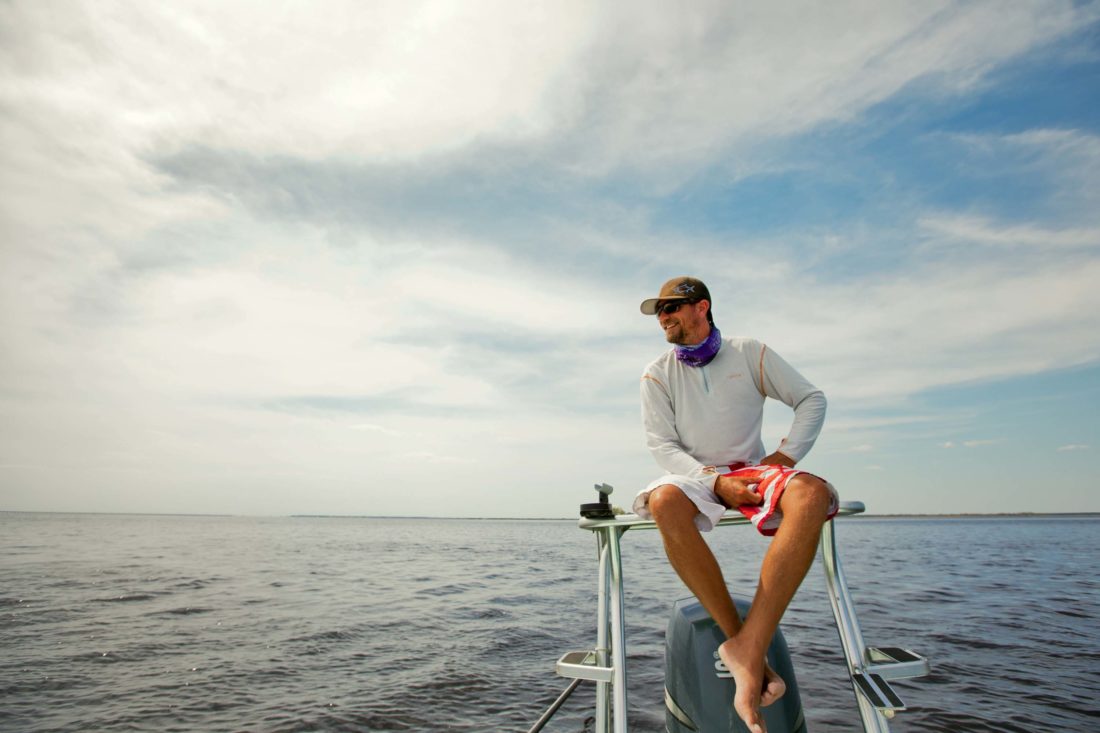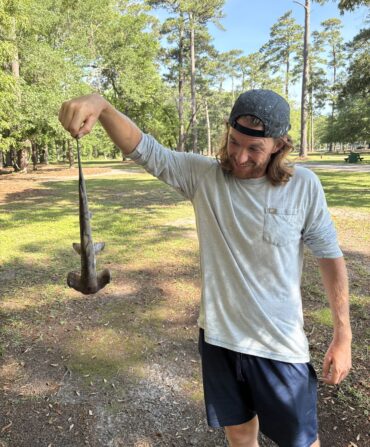“See that ripple in the water there, coming at us?”
David Mangum is practically whispering in my ear while pointing over my shoulder into the bay, employing his innovative and unusual guiding technique. “That’s a fish, and it will be right here”—he now points to a spot in the water maybe ten feet away from the bow of the boat—“in a couple of seconds. Wait for it…wait…and go!”
I cast and then strip my fly once and immediately feel the unforgettable pull of a tarpon, a fish that the baseball great Ted Williams once described as “dynamic, eager, tackle-busting…sensational, spectacular.” It’s worthy of all superlatives. The tarpon on the end of my line shakes its head and leaps. It makes an impossibly large hole in the water when it reenters. And then it breaks me off. The whole mind-clearing encounter has lasted all of five seconds. I immediately want to do it all again.
It’s a spring day on the Florida Panhandle. My brother Justin and I have snuck away from a family beach week for a day with Mangum, who has become perhaps the area’s top tarpon guide and an innovator in the space. We’re in Apalachee Bay, near the town of Carrabelle, along a stretch of beach known as the Forgotten Coast for its lack of high-rises and general hubbub. For a long time, that moniker also applied to the area’s tarpon fishery, a relative unknown when compared with places like the Keys and Boca Grande, the entrenched icons of that world. And while the Panhandle tarpon scene is no longer a secret—there can be some busy days on the water—it remains less popular than its counterparts to the south.
The tarpon in the Panhandle bays tend to bite well, thanks to the water’s slight tint (a result of the myriad freshwater rivers that drain into them). But there are fewer of them in this area than there are in the Keys, and they can be hard to find. Which is a good reason to book a guide like Mangum.

Mangum, a wiry forty-eight, is a native Panhandler. He grew up in Destin, where he began fly fishing at age twelve. After a few years in college and seasonal stints as a fishing guide in Alaska, Mangum started guiding on the Panhandle in 1999. A decade later, he took over Shallow Water Expeditions, a guide service based out of Old Florida Outfitters at the Watercolor resort in Santa Rosa Beach. He and his ten full-time guides concentrate on the roughly two hundred miles between Florida’s Big Bend region and Destin, which includes the Forgotten Coast and the popular beach resorts off of 30A. They all share information on the fishing and the conditions and, save for storm blowouts, they fish year-round for redfish, cobia, trout, jacks, false albacore, and pretty much any fish that will eat a fly or a lure.
Tarpon, though, are the glamour fish, and the species Mangum concentrates on almost exclusively from spring through late summer. He’s been fishing for, and studying the habits of, tarpon in the Panhandle for three decades. “Tarpon are why I became a guide,” he says. “They are everything you’d ever want in a fly-rod fish.”
Because of the work he’s put in on the flats, and the innovations that have sprung from that work, Mangum has become a favored guide of the heads of industry stalwarts, like Orvis and Simms, and of some of his fellow tarpon guides, like Steve Huff. Mangum spent years studying and mapping out the bays—which don’t have as many obvious reefs and points as the Keys—and now has go-to spots, with names like Yellow Brick Road and Dreamland, that aren’t necessarily apparent to the untrained eye. He protects these locations. “Most people leave me alone when I’m on them,” he says. And just in case they don’t get the message, Mangum’s skull-shaped anchor buoy puts the point across.
Mangum has created various new flies. His latest, the Dragon Tail, has an almost alarmingly lifelike tail and is now available commercially through Orvis. But his most interesting—and effective—innovation is in his boat. On the bow of his eighteen-foot skiff is what appears to be an extra-tall casting platform. In reality, the platform—which he had custom-made—is for him. You, the angler, stand on the bow as he stands above and behind you, giving instructions and sometimes taking hold of your fly rod to point out a fish.
Mangum dreamed up the idea five years ago, and it’s since spread among some of his guiding brethren. “For a while, I was standing in the bow right next to my clients, which worked pretty well,” he says. “But then I thought, Why not add some elevation? Now I can see the fish and relay the information really quickly and calmly. It gives us an extra five seconds to set up.” All of which means more chances for a mind-clearing encounter with a mind-blowing fish.








